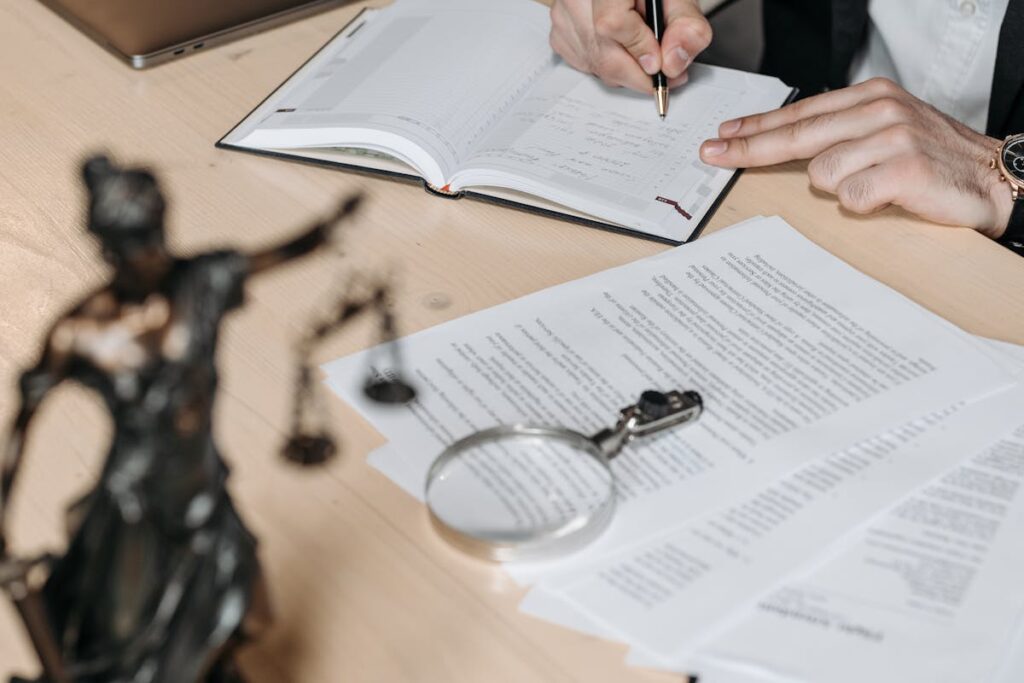Personal injury attorneys operate within a complex web of responsibilities largely unseen by their clients. They balance empathetic client consultations with aggressive insurance negotiations while meticulously documenting evidence and meeting strict legal deadlines. Their days shift between collaborative meetings with medical experts and solitary analysis of case precedents. Behind each settlement check lies countless hours of strategic planning, evidence gathering, and tactical decision-making—professional efforts that transform painful accidents into pathways toward justice and financial recovery.
Conducting Initial Client Consultations and Case Evaluations
The first essential responsibility in a personal injury attorney’s daily workflow involves conducting thorough initial client consultations and case evaluations. During these meetings, attorneys gather comprehensive information about the incident, injuries sustained, and potential liability issues while establishing rapport with prospective clients.
The attorney focuses on evaluating client eligibility by examining the statute of limitations, jurisdiction questions, and whether the case meets legal thresholds for viable claims. Simultaneously, they begin evaluating case strengths through preliminary evidence review, witness statement analysis, and identification of potentially recoverable damages.
These initial evaluations require balancing technical legal analysis with compassionate understanding of clients’ situations. Attorneys must make pivotal decisions about case acceptance while setting realistic expectations regarding potential outcomes, timeline projections, and compensation possibilities—all while maintaining professional boundaries and ethical standards.
Investigating Accident Scenes and Gathering Evidence
Effective case-building begins with meticulous accident scene investigations, where personal injury attorneys document critical evidence before it deteriorates or disappears entirely. They often arrive at crash sites within hours of incidents, systematically photographing accident sites from multiple angles to establish visual records of skid marks, vehicle positioning, and environmental factors.
Beyond physical evidence, attorneys focus on human testimony, collecting witness statements while memories remain fresh and uninfluenced. This process involves identifying potential witnesses, conducting structured interviews, and preserving accounts through signed affidavits. Attorneys also secure surveillance footage, police reports, and medical records to construct thorough evidence portfolios. These investigative efforts establish causation patterns and liability frameworks that ultimately determine a claim’s viability and potential value in settlement negotiations or courtroom proceedings.
Reviewing Medical Records and Consulting With Healthcare Providers
Medical documentation forms the cornerstone of every personal injury claim, requiring attorneys to develop sophisticated analytical skills for interpreting complex healthcare records. Personal injury lawyers meticulously examine diagnostic reports, treatment plans, and prognoses to establish causation between accidents and resulting injuries.
The process involves compiling medical summaries that translate technical terminology into comprehensible narratives for judges and jurors. These summaries highlight critical findings while connecting medical conclusions to liability arguments.
Collaborating with medical professionals provides essential expert perspectives that strengthen cases. Attorneys regularly consult with physicians, specialists, and rehabilitation experts who can verify injury severity, treatment necessity, and long-term implications. These professional relationships guarantee accurate valuation of damages and help attorneys anticipate defense challenges to medical evidence—ultimately maximizing compensation for injured clients.
Negotiating With Insurance Companies and Claims Adjusters
Personal injury attorneys employ strategic communication tactics when engaging with insurance companies, balancing assertiveness with professionalism to protect their clients’ interests. They strategically utilize detailed documentation, including medical records, expert testimonies, and evidence of damages, as leverage to strengthen their negotiating position. Attorneys set realistic compensation expectations with clients while simultaneously presenting compelling cases to claims adjusters that justify maximum recovery based on precedent, liability factors, and the full scope of damages incurred.
Strategic Communication Tactics
A fundamental component of personal injury representation involves mastering strategic communication with insurance companies and claims adjusters. Attorneys must carefully calibrate their approach, alternating between assertive advocacy and collaborative problem-solving based on case specifics and adjuster personality.
Persuasive written communication forms the backbone of effective negotiation, with demand letters serving as detailed case narratives that frame injuries within relevant legal frameworks. These documents strategically present evidence while anticipating counter-arguments. Simultaneously, strategic oral advocacy requires attorneys to listen actively during discussions, identifying subtle openings for settlement while maintaining firm positions on client interests.
The most effective attorneys recognize when to escalate pressure through litigation threats and when patience might yield superior outcomes, always preserving professional relationships that facilitate current and future claim resolutions.
Documentation As Leverage
Thorough documentation serves as the cornerstone of effective leverage in personal injury negotiations, transforming abstract claims into compelling narratives supported by objective evidence. Attorneys meticulously engage in strategic documentation, organizing medical records, expert testimonies, and accident reports into cohesive evidence packages that insurance adjusters cannot easily dismiss.
Document organization becomes tactical—arranging materials to highlight causation, liability, and damages while anticipating counterarguments. Each photograph, medical bill, and witness statement serves as a negotiation tool when properly contextualized. Attorneys strategically time the release of documentation, sometimes withholding certain elements until precisely the right moment in negotiations. This calculated approach creates momentum toward favorable settlements by systematically dismantling insurance companies’ standard objections through irrefutable evidence rather than mere assertions.
Setting Compensation Expectations
Setting realistic compensation expectations represents one of the most delicate aspects of a personal injury attorney’s work, requiring both analytical precision and strategic foresight. Attorneys must balance client hopes against case realities when determining settlement ranges that accurately reflect injury severity, liability strength, and available insurance coverage.
The process involves calculating both economic damages (medical expenses, lost wages) and non-economic damages (pain, suffering), while understanding client financial needs to establish minimum acceptable outcomes. Experienced attorneys analyze comparable case precedents and jurisdiction tendencies to develop evidence-based value assessments.
This calibration process serves dual purposes: it prevents client disappointment from unrealistic expectations while establishing strategic negotiation parameters with insurance adjusters. The attorney must communicate these ranges with transparency, preparing clients for the uncertain nature of personal injury compensation without diminishing their advocacy commitment.

Drafting and Filing Legal Documents and Court Motions
While client interactions often receive the most attention, the meticulous drafting and filing of legal documents form the backbone of a personal injury attorney’s daily practice. Attorneys spend considerable time crafting complaints, discovery requests, settlement demands, and other critical paperwork that must adhere to strict jurisdictional requirements.
The process involves drafting complex motions that can greatly impact case outcomes, including motions to compel evidence, exclude testimony, or seek summary judgment. Each document requires precise language that anticipates opposing counsel’s arguments while advancing the client’s position. Filing court-specific paperwork demands attention to detail, as even minor errors in formatting or timing can jeopardize a case. These administrative responsibilities, though less visible than courtroom advocacy, often determine whether an injured client ultimately receives fair compensation.
Preparing Clients for Depositions and Testimonies
Testimony preparation represents one of the most critical responsibilities in a personal injury attorney’s practice. Attorneys devote significant time to preparing clients for compelling testimony, ensuring they understand the legal implications of their statements while maintaining authenticity.
The process typically begins weeks before scheduled depositions, with attorneys conducting mock sessions that simulate potential cross-examination scenarios. These practice runs help clients become comfortable with answering questions directly while avoiding speculative responses that opposing counsel could exploit.
When guiding clients through deposition process, attorneys focus on teaching them to listen carefully, answer truthfully, and avoid volunteering unnecessary information. They also prepare clients for potentially aggressive questioning tactics designed to provoke emotional responses. This preparation extends beyond technical instruction to include psychological support, helping clients manage anxiety while presenting their experiences clearly and consistently.
Building Networks With Expert Witnesses and Specialists
Successful personal injury attorneys maintain extensive professional relationships that extend far beyond client preparation. They regularly cultivate connections with medical experts, accident reconstructionists, economists, and vocational specialists who can provide critical testimony to strengthen cases. This expanding professional network becomes an invaluable resource when specific expertise is needed to establish liability or quantify damages.
The most effective attorneys invest time in fostering collaborative relationships with these specialists, ensuring they understand the nuances of legal standards while respecting their professional independence. They maintain detailed databases of experts categorized by specialty, geographic location, and previous case performance. Regular communication—even outside active cases—helps maintain these professional bonds, allowing attorneys to quickly mobilize the right specialists when a new matter requires specialized knowledge or testimony.
Managing Case Timelines and Meeting Legal Deadlines
The meticulous management of case timelines represents one of the most crucial responsibilities in a personal injury attorney’s practice. Successful attorneys develop systematic approaches for tracking statute of limitations, court filing deadlines, and discovery schedules across multiple cases simultaneously.
Prioritizing deadlines involves strategic evaluation of each case’s requirements, often using specialized legal calendar software to establish notification systems days or weeks before due dates. Attorneys must allocate adequate preparation time for complex filings while monitoring progress on investigative tasks, document collection, and expert witness preparation. This continuous oversight prevents costly mistakes that could jeopardize a client’s right to compensation.
The consequences of missed deadlines can be severe—from case dismissal to professional sanctions—making timeline management not merely administrative work but a fundamental ethical obligation.
Staying Current With Personal Injury Laws and Precedents
Effective personal injury representation demands unwavering commitment to legal scholarship and continuous education. Attorneys must dedicate substantial time to monitoring legislative changes that affect liability standards, damage caps, and procedural requirements across jurisdictions.
This vigilance extends to analyzing legal precedents through regular review of appellate decisions that may reshape established practices. Successful attorneys maintain subscriptions to specialized legal publications, attend continuing education seminars, and participate in professional associations dedicated to personal injury law. Many firms establish systematic approaches for disseminating relevant updates to their legal teams, ensuring all attorneys can leverage emerging legal interpretations to benefit their clients. This knowledge acquisition process isn’t merely academic—it translates directly into strategic advantages in negotiations and courtroom arguments when attorneys apply evolving legal frameworks to their clients’ unique circumstances.
Frequently Asked Questions
How Do Personal Injury Attorneys Balance Multiple Cases Simultaneously?
Personal injury attorneys balance multiple cases by efficiently managing client expectations, prioritizing deadlines, and coordinating with support staff. They implement case management systems, delegate administrative tasks, and allocate time based on case complexity and urgency.
What Technology Tools Do Personal Injury Lawyers Use Daily?
Personal injury lawyers rely on electronic case management systems to track deadlines and client communications. Cloud-based document storage facilitates secure file access, while specialized software enables efficient legal research, document automation, and settlement calculations.
How Do Attorneys Handle Emotional Stress From Traumatic Client Cases?
Attorneys manage emotional stress through structured stress management techniques, including mindfulness practices and professional boundaries. Client counseling strategies involve empathetic listening while maintaining analytical distance to prevent compassion fatigue and guarantee effective representation.
What Percentage of Cases Typically Go to Trial Versus Settlement?
In the personal injury field, approximately 95-97% of cases resolve through settlement negotiation rather than trial. The litigation allocation skews heavily toward pre-trial resolution, though attorneys prepare thoroughly for both potential outcomes.
How Do Attorneys Bill Clients for Personal Injury Cases?
Personal injury attorneys typically operate on contingency fee arrangements, not hourly rates. This billing practice allows clients to pursue claims without upfront costs, as attorneys collect a percentage only when compensation is secured.

